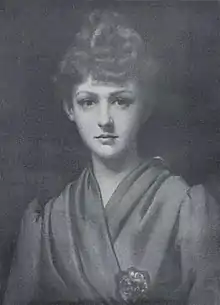Violet Milner, Viscountess Milner
Violet Georgina Milner, Viscountess Milner (née Maxse; 1 February 1872 – 10 October 1958) was an English socialite of the Victorian and Edwardian eras and, later, editor of the political monthly National Review.[1] Her father was close friends with Georges Clemenceau,[2] she married the son of Prime Minister Salisbury, Lord Edward Cecil, and upon his death, Lord Alfred Milner.

_3.jpg.webp)
Violet was the youngest of four children born to Admiral Frederick Maxse and Cecilia Steel. Her siblings were Gen. Sir Ivor Maxse (1862–1958), a British Army officer of the First World War; Leopold Maxse (1864–1932), editor of the National Review, and Olive Hermione Maxse (1867–1955), a model for Edward Burne-Jones.[3][4]
With the breakdown of peace negotiations in South Africa between English and Dutch settlers, leading the Boer War in 1899, the British increased their military presence there by dispatching 2,000 soldiers. Among them was Major Edward Cecil and his wife.[5] Arriving in Cape Town on 26 July, Lady Edward wrote often to her cousin, future Prime Minister Arthur Balfour, in support of England and the policies of its High Commissioner for South Africa, Sir Alfred Milner. With the Cecils and Milner residing at Government House, the three were good friends until August 14th, when the Cecils were ordered to move north.[6] When Major Cecil became trapped in the Siege of Mafeking (from 13 October 1899 to 17 May 1900), Violet stayed at Groote Schuur, the estate of mining magnate and politician Cecil Rhodes. She wrote of her experiences during this time in her autobiography, "My Picture Gallery", a book published in 1951.
She married, firstly, Lord Edward Cecil, the youngest son of Prime Minister Salisbury on 18 June 1894. She exchanged letters with Alfred, and alongside Violet Markham she established the Victoria League in 1901 to promote Milner's imperial vision of the British Empire.[7] She met up with Lord Milner again at a Christmas party held at Lord Goschen's country estate Seacox, Hawkhurt in December 1905.[8] Lord Edward died on December 13, 1918 of the Spanish flu, and she married Lord Milner on 26 February 1921.[9]
Lady Edward and Lord Milner were married 12 days after Lord Milner's retirement from Prime Minister Lloyd George's government on 14 February 1921. They had a great marriage. On 22 May 1928 she turned over important information relating to World War I and Lord Milner's role at the Doullens Conference in France to the Public Record's Office.
Upon Lord Milner's death in May 1925, Violet inherited nearly £46,000 (£2.8 million in 2020).[10] In 1929 she sold Sturry Court, Milner's residence in Canterbury, to Kings School, which is today the location of a junior high school. However, she continued to maintain Great Wigsell, her manor home in Salehurst, and 13 Manchester Square, their joint house in London.
Lady Milner took over as editor of the conservative journal National Review after the death of her brother Leopold Maxse in 1932, having supported the publication since he fell ill in 1929.[9] The magazine was known for its opposition to imperial Germany prior to World War I, and to appeasement in the interwar years. Its editor was staunchly defended by conservative leader Bonar Law.[11]
In 1917, Prime Minister Clemenceau, speaking to French President Raymond Poincare, famously said about Lord Milner:
"He is an old friend of mine. We admired and loved the same woman. That's an indissoluble bond."[12]
Viscountess Milner was present in France on November 11, 1933, the 15th anniversary of the Armistice, where she dedicated a marble bust of her late husband, Alfred, in a conference room on the second floor of Doullens Town Hall. It was here at Lord Milner's urging, in a conference attended by Clemenceau, Poincare, and French and English Generals on March 26, 1918, that the Western Front was united under a single command in World War I.
She died 10 October 1958 at her home near Hawkhurst.
References
- "Obituary: Viscountess Milner – Brilliant Talker and Hostess". The Times. The Times Digital Archive. 11 October 1958. p. 8.
- The Times, 6/30/00, pg. 8
- Mosley, Charles, ed. (2003). Burke's Peerage, Baronetage & Knighthood (107 ed.). Burke's Peerage & Gentry. pp. 351–352. ISBN 0-9711966-2-1.
- "Sir Edward Coley Burne-Jones Bt., A.R.A., R.W.S. (1833-1898) , Portrait study of Olive Maxse, probably for 'The Sirens'". Christie's. Retrieved 18 May 2019.
- London Gazette, 17 Oct 1899, pg. 6262
- Thompson, J. L., "Forgotten Patriot", pgs. 143, 145
- Cecil, Hugh; Cecil, Mirabel (2005). Imperial Marriage: An Edwardian War and Peace. History Press. ISBN 978-0-7509-3799-3.
- O'Brien, Terence, "Milner", pg. 230
- Cecil, Hugh. "Milner, Violet Georgina". Oxford Dictionary of National Biography (online ed.). Oxford University Press. doi:10.1093/ref:odnb/35039. (Subscription or UK public library membership required.)
- O'Brien, pg. 389
- Beaverbrook, Lord, The Decline and Fall of Lloyd George, New York: Duell, 1963, pgs. 194-195
- Thompson, pg. 334
Primary Sources
- Archive.org (sign up to view links and sources)
- The Times (of London) archive website
- Beaverbrook, Lord The Decline and Fall of Lloyd George, New York: Duell, Sloan, 1963
- The London Gazette
- Milner, Violet (Viscountess Milner), My Picture Gallery: 1886 - 1901, London: John Murray, 1951
- O'Brien, Terence, Milner, London: Constable, 1979
- Thompson, J, Lee, Forgotten Patriot: A life of Alfred, Viscount Milner of St James's and Cape Town, 1854-1925, Cranbury, NJ: Rosemont Publishing, 2007